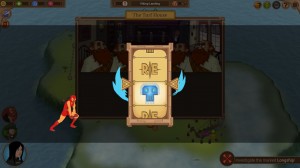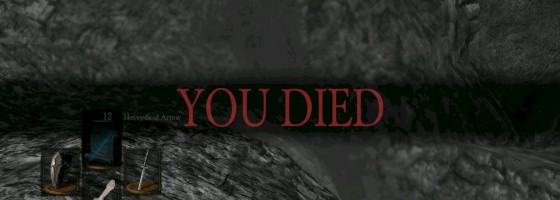Skyshine’s Bedlam which was released earlier in September is both the latest game to follow in the challenging rogue-like footsteps of FTL, and the latest game to be marked down by fans because of it. Creating intentionally difficult games is tough (no pun intended) and requires a careful hand when it comes to challenge. People like a challenge, but the key factor has to do with the player’s control over the situation.
Figuring out Failure:
Games built around rogue-like elements have had a huge surge of popularity and was a topic of a post from a few years ago. The option to create a challenging title with huge replayability when done right can be a great title. However, for every rogue-like that comes out and makes a huge impression, there are several more that crash and burn under their own design and difficulty.
This topic is one that I’ve talked about before, but recent examples are just too good not to bring it back up again. While games like Super Meat Boy, Dark Souls, Darkest Dungeon and Skyshine’s Bedlam may all seem to be in the same camp of hardcore difficulty, there is a critical difference in their difficulty design.
The magic word is “Control;” specifically: The player’s control over the difficulty of the game. Players are more accommodating to hardcore difficulty when they have a hand in how hard the situation is. No matter how hard the game is, if the player has some way to control the difficulty either through design or skill, they are far more accepting of failure and retrying.
Super Meat Boy and Dark Souls are examples of this through player skill. Each stage or section of the game’s difficulty is designed around the player’s skill level, or what I called Subjective Difficulty. The point is that the levels are designed to challenge the player to become better at the game and because of it, different skill levels will take varying amounts of time to get through it. Both titles lay their challenges out pretty neatly for the player, forcing them to adapt or die to the situation. With rare exception, the player is never put into a situation where they’ll just die without any provocation or alert from the game.
In terms of controlling the difficulty through design, there is of course one example that I have to go to: The World Ends With You. The game is one of my favorite titles and part of that is the player’s ability to control the difficulty at any time.
They decide how many enemy encounters to fight at once, the difficulty of the game and the max HP to bring into a fight.
The best part? The harder the player makes it, the more rewards and higher quality rewards they’ll earn for pushing themselves.
This is similar to how Diablo 3 changed its difficulty with recent patches, but to a higher degree.
Now that we’ve talked about games where it worked, but why are titles like Skyshine’s Bedlam and Darkest Dungeon under fire from their fans over their difficulty? The answer has to do with the player losing control.
Out of your Hands:
As we’ve talked about, if the player is the determining factor of how hard a game is, they are far more accepting of retries and harder titles. However, if the difficulty is out of their hands for one reason or another, they’re going to get more frustrated and possibly quit. The reason is that what makes the game difficult has no bearing on the player’s skill or choices; it’s like a one-man game of Russian roulette: It doesn’t matter anything you do, you’re going to end up losing
Randomized elements in rogue-likes have become a staple of the genre as it provides replayability and unpredictability to challenge the player, but when this goes too far and the player’s fate is tied to elements completely out of their control, frustration sets in.
Starting with Skyshine’s Bedlam, the game follows ironman rules for combat: Someone dies and they’re gone for good. Different classes have different starting health and one of the best strategies is to protect your glass cannon units. The problem is that when combat starts, units can be randomly placed around the map. So there is a chance that your weakest units will be right next to the enemy and there will be no way to save them. You can imagine how frustrating this can be if that unit is a veteran that you had from the beginning. There’s nothing the player could have done, no strategy to avoid it, if it happens then you’re out a unit.

Darkest Dungeon has had a lot of trouble balancing the late game challenges without stepping on the toes of people just learning it
Darkest Dungeon for the entirety of its Early Access life has been struggling with difficulty balance. The problem is that the difficulty curve is too polarizing; with the early game being very difficult and the late game very hard to lose.
Part of the problem with the early game has to do with the severity of critical hits. Critical hits in Darkest Dungeon are very powerful and can take a character to death’s door very easily.
They are of course completely random, with the player having slight control due to the light system.
The problem is that a few critical hits at the start of a mission and the player will be unable to continue due to the damage and the game’s design built around few means of healing.
Not only that, but if you leave a mission early you’ll also forfeit all the money you spent on resources that you took in with you, making subsequent missions harder. The developers added fuel to the fire with the inclusion of corpses which once again caused a huge disparity between the early and late game; expert players didn’t mind them but they were another roadblock for someone brand new.
The Darkest Dungeon’s issue with control is that they’re trying to create a game where you’re supposed to fail at the start; similar to X-Com and how your initial squaddies will most likely die. Then through determination and upgrades, you can turn the tide and start making progress. The problem once again is the progression model and how it’s tied to your people. The characters you recruit will only get access to better skills and gear via surviving and leveling up; whereas in X-COM, better gear can supplement new characters and makes sure that there is some form of permanent progress.
Losing a high ranked character in X-Com is a setback, but you still have all the value and resources they earned for you to show that they meant something, and a new character won’t start completely back at square one. Lose a high level character in Darkest Dungeon and you are back to square one with someone new. Honestly, I don’t know what the solution will be and I’m curious to see how Redhook Games handles this imbalanced difficulty curve.
Renowned Explorers by Abbey Games is a great example of giving the player control. Every level is procedurally generated with random events and you never know what’s going to happen. The player has to decide just how far they want to explore and whether or not to risk major debuffs for getting more resources that can help them in later quests. The developer effectively gave the player a noose and asks them how long they want to risk before they’re hung by it. The losses you’ll experience in the game will mostly come by your own choice screwing you, not from the unseen hand of the developer.
Despite the hardcore difficulty of FTL’s final fight, the fact that it is set gives the player an idea of what they need to win and if they don’t get it, there’s always next time. The key point is that the player knows what to expect, instead of just leaving everything up to chance.
You can’t please everyone:
At the end of the day, you’re never going to be able to please everyone in terms of difficulty. There will always be people who will find your game laughably easy and those that fail within the first half hour of play. A master understanding of game design can only go so far to accommodate these different skill levels, but at the end of the day you need to decide just what the intended skill level of your game is?

Renowned Explorers can be a tough game, but it’s always about letting the player decide how far they are willing to risk things
From there, you can balance and design everything about that, while still finding ways to accommodate both extremes.
However, and it’s a big however, once you’ve settled on where you want the difficulty curve to be, YOU CANNOT CHANGE IT. It doesn’t matter if people find your game too hard or too easy, you need to be really careful with any changes to your core gameplay.
The problem Darkest Dungeon had with the corpse mechanic was that it was added in long after the game was put on Early Access and was seem as an unnecessary addition added to punish expert players. If it would have been there from the original concept, it would have been looked at as part of the core experience.
By adding it later into the game’s development, the change affected all aspects of party composition, strategy and of course difficulty; leading to Redhook having to alter the corpse mechanic very quickly after its release. And once again, this change really affected how the early game plays out, before you get high level characters and trinkets, not the end game experts.
Some options have been to let players decide what elements or mechanics to leave on which is what Misfits Attic is doing with Duskers. That way, everyone who wants a challenge can play the experience as the developer intended, but people starting out or who are having trouble can still make things easier for them.
Great difficulty design should not punish one side of your fan base and should make the player feel like they’re improving, not getting stomped in the mud. Achieving that balance is very hard and not many developers can do it, but some of the best games around are those that can keep everyone going no matter how difficult things get.
If you enjoyed the post, please consider donating to the Patreon campaign. Your donations help keep Game-Wisdom ad free and let me keep putting out great content.



